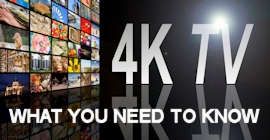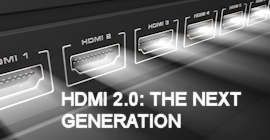Help > 4K/8K Ultra HD
4K/8K Ultra High Definition: What you need to know
4K Ultra High Definition TV is here, and now can be purchased for a few hundred dollars. 1080P TV (the previous "go-to" standard) is a thing of the past, most alll TVs are now 4K. So what exactly is a "4K TV"?What is 4K TV?
The previous HD standard had a television capable of transmitting at least 720 lines, but more commonly 1080 lines of pixels, horizontally. Most TVs in this format use what is called a 16:9 aspect ratio - which compared to the previous CRT TVs, was more elongated and more desirable to closely match the cinema standard. Today's NEW standard is dubbed "4K" or "4 thousand" lines. Other acronyms, such as "UHD" (Ultra High Definition) are also commonly used to describe a resolution that is the next generation beyond 1080. A TV is deemed to be a 4K or UHD TV if it is capable of at least 3,840 (wide) x 2,160 (high) pixels. Some TV manufacturers (Sony, for example) call all their new TVs "4K Ultra High Definition" or "4K UHD" for short.
Today (as of February 2020), 4K content is becoming very popular, UHD Blu-ray players, AppleTV 4K and Microsoft XBOX 1X can deliver stunning 4k video quality for movies and gaming . There are promises of some TV channels broadcasting in 4K, however, until there is a decent amount of 4K filmed or broadcast content available in 4K, most of our content will still arrive in 1080P format (and will still look great on a 4K TV).
8K/10K and HDMI 2.1 - NEW SPECIFICATION
The HDMI 2.1 specification was released by HDMI LLC in 2017. It defined certain standards and specifications for hardware, cables, and software to adhere to. Advanced features such as 10K content (which is 5 times the clarity of 4k/60Hz), eARC, Dynamic HDR, Variable Refresh Rate (VRR), Auto Low Latency Mode (ALLM), Quick Media Switching (QMS) and Quick Frame Transport (QTF) are all new capabilities with HDMI 2.1 and will dramatically improve video quality by reducing lag, switch times and picture depth and detail.
This standard is brand new and there are few devices that adhere to the HDMI 2.1 specification and there is no certification process for the new cables that will be required for these high resolutions. My Cable Mart expects 2020 to be a big year for HDMI 2.1 and will have premium quality certified cables as soon as they become available. We do have 8K rated cables currently that have been independantly tested to adhere to the 48Gbps standard, however they are not currently HDMI platinum certified cables.
4K and HDMI 2.0
The HDMI 2.0 specification was released by HDMI LLC in 2013. It defined certain standards and specifications for hardware, cables, and software to adhere to. Advanced features such as 4K content up to 60Hz (which is 4 times the clarity of 1080P/60Hz), 32 audio channels, 1536Hz audio sampling rates, and the support for wide angle theatrical 21:9 aspect radio are some of the many capabilities of this new video and audio standard.
4K, HDMI 2.0, and HDCP 2.2
Along with the release of HDMI 2.0 came HDCP 2.2 (replacing the previous standard of HDCP 1.2). HDCP (High-Bandwidth Digital Content Protection) is a specification developed by Intel Corporation to protect digital content passed between various electronic devices (computers, TVs, splitters, home theatre receivers, switches, blue ray players, media players, etc).
The use of HDCP is to prevent the unauthorized copying and distribution of such high definition signals. For the most part, consumers don't need to worry about HDCP. Physically, it is a tiny circuit inside a Blue-Ray (for example) and a TV. When audio and video content is transmitted via an HDMI cable from such source to the destination, the circuit used "hand-shakes" that check to make sure the content adheres to the HDCP standards. Otherwise, a TV might display an error such as "HDCP Error".
HDCP 2.2 can cause issues with a consumer audio/video equipment use. Unless you purchase equipment (TVs, Blue-Rays, receivers) that are ALL HDCP 2.2 compliant, they most likely will not play nice with each other (according to C-Net). When you purchased your new 4K UHD TV, if purchased on or after 2015, it SHOULD be "HCDP 2.2" compliant. Many TV manufacturers have labeled their HDMI ports "HDCP 2.2" or made other clear markings on the rear connection panels of their TVs. This means the TV can accept content from a device that is EITHER HDCP 1.2 OR HDCP 2.2. Making sure your new 4K UHD TV supports HDCP 2.2 is an absolute MUST. Without such support, such TV may not be able to support or communicate with newer blue-ray, media box, or home theatre systems that are HDCP 2.2 compliant.
HDMI 2.0 Cables and 4K Support
4K content can be displayed in a variety of different refresh rates, formats, and bit-rates. The BOLD/ORANGE formats shown below are new to the HDMI 2.0 specification. The formats in BLACK have been supported since HDMI version 1.4. The "4:4:4" value refers to the chroma sub-sampling capability of a TV's picture. 4:4:4 is considered optimal. A "4:4:4 at 60 Hz" (which is considered the "holy grail") can only be obtained from a v2.0 HDMI Cable sustaining 18Gbps data speed:
|
|
8bit |
10bit |
12bit |
16bit |
|
4K@24 |
RGB 4:4:4 |
RGB 4:4:4 |
RGB 4:4:4 4:2:2 |
RGB 4:4:4 |
|
4K@25 |
||||
|
4K@30 |
||||
|
4K@50 |
RGB 4:4:4 4:2:0 |
4:2:0 |
4:2:2 4:2:0 |
4:2:0 |
|
4K@60 |
An HDMI Cable, that is tested against the version 1.4
High Speed testing specification (10.2Gbps), will
support 4K content @ 30Hz .
However, 4K support beyond 50Hz (typically at 60Hz
in advanced 4K UHD TVs) can only be supported using an
18Gbps capable HDMI cable (or a v2.0 HDMI). As there is currently NO
audio/video content supporting 4K @ 60Hz, for most
consumers, the use of an existing High Speed v1.4 HDMI cable
will provide the 4K at 30Hz support needed. There are
no plans for any cinema or broadcast content to be released
beyond 4K @ 30Hz. All (North American) movies are
filmed at 24fps. There is some experimentation
with 48fps and 72fps - but currently, no commercial films
have been released at such frame rate.
As of February, 2016, the LONGEST copper-based HDMI cable manufactured tested to meet HDMI v2.0 specifications is 40ft. A cable must sustain data speeds of 18Gbps or better to pass such ATC tests. My Cable Mart is aware of many on-line, and bricks-and-mortar stores that are providing falsified information about their HDMI cables. Some manufacturers are making claims of a copper HDMI cable of 100 feet in length meeting HDMI 2.0 specifications. We report such false claims directly to HDMI LLC, and we are aware of multiple companies that have had to retract or modify such claims.
For MOST 4K content, which is broadcast at 30Hz, an HDMI cable tested to the version 1.4 specification (or 10.2Gbps) will work perfectly. Only those consumers who want to future-proof their HDMI-capable broad to 60Hz will ever need to use an HDMI 2.0 cable (capable of 18Gbps at 60Hz).
All our HDMI cables that will support 4K@60Hz to 4:4:4 Chroma sub-sampling are available HERE.
Be sure to read up on our article on selecting your HDMI cable as well.
HDMI 2.0 Beyond 40ft
So begins the dilemma. HDMI at 18Gbps (meeting v2.0 testing specifications) is achievable using more expensive glass fiber cables. In fact, distances of up to 1000ft are currently achieveable using this technology. Hybrid HDMI cables that will be a combination of copper (to provide power) and glass fiber are on the horizon. My Cable Mart expects to carry such cables once they have passed and are certified by HDMI LLC to meeting rigid version 2.0 testing.






